ASUS M2N32-SLI & Epox MF570SLI: AM2 Wunderkinder
by Wesley Fink on June 28, 2006 5:10 AM EST- Posted in
- Motherboards
General Performance
With the Memory Controller on the Athlon 64 Processor, Winstone benchmarks are no longer very revealing of motherboard performance. With the same CPU (and the same memory controller on that CPU) both Winstones are tightly clustered. The only deviation from that is that boards that are tweaked for best gaming performance are often near the bottom of a tight range of benchmark performance numbers. The Winstone tests themselves are rapidly becoming dated, and are no longer supported by PC Magazine/VeriTest. While Winstones are still useful in providing real world performance data in CPU testing, we have dropped Winstones from our standard motherboard test suite.
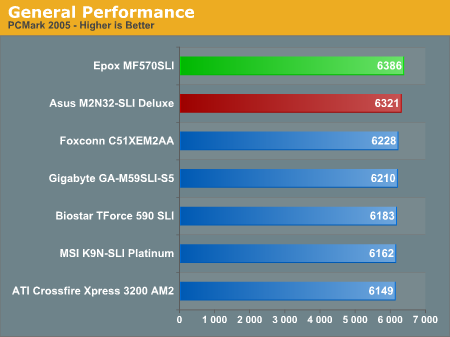
PCMark 2005 results for the seven AM2 boards show the Epox 570 at the top of the performance chart, followed closely by the ASUS M2N32-SLI. These results are very much in line with other results. Despite the close results in these tests, PCMark05 is proving to be a useful overall performance benchmark. It is generally more sensitive than the older Winstones and PCMark04 to recent improvements in PC architecture. PCMark05 results in general relate well to the other performance results we find in our board tests - providing a quick and reliable snapshot of board performance compared to other motherboards.
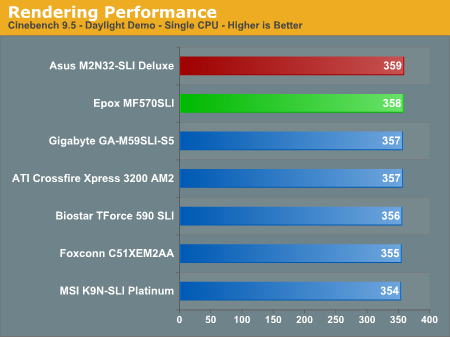
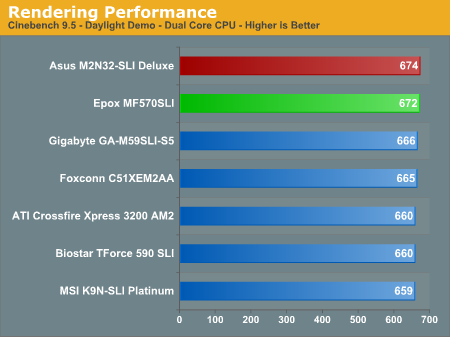
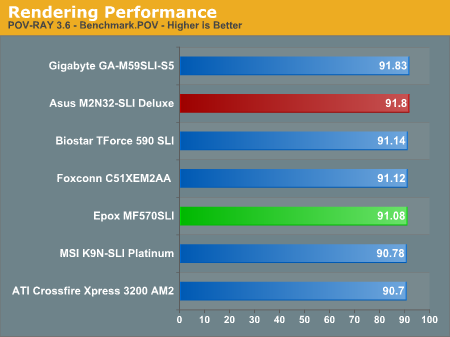
We have replaced Winstones with two benchmarks that use rendering to test system performance. Cinebench 9.5 and POV-RAY 3.6 benchmarks both heavily stress the CPU subsystem while performing graphics modeling and rendering. We utilize the standard benchmark demos in each program along with the default settings. Cinebench 9.5 features two different benchmarks with one test utilizing a single core and the second test showcasing the power of multiple cores in rendering the benchmark image.
While results are generally close in Cinebench, the ASUS 590 tops both Single-Core and Dual-Core test results, followed closely by the Epox in both tests. POV-Ray results are extremely close across DDR2 platforms and show the Gigabyte to be the top performer, followed closely by the ASUS. The Epox performance on POV-Ray 3.6 falls in the middle of the pack.
3D Graphics
The 3DMark benchmarks, published by Futuremark, are probably the most widely quoted gaming performance benchmarks available. While the benchmarks are based on game sequences written by Futuremark to reveal subtle differences in gaming performance, they still have to be considered synthetic benchmarks. They are useful for broad graphics comparisons, but they are no substitute for benchmarks with real gaming engines that are currently being played.
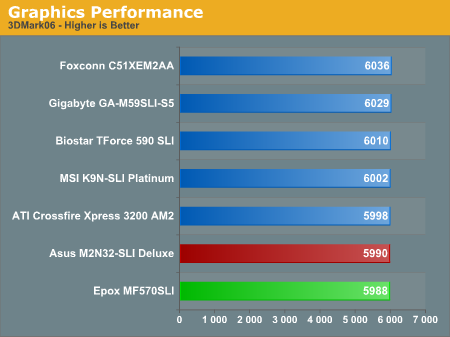

After topping PCMark2005 it was a surprise to see both ASUS and Epox nailing down the bottom of 3DMark performance. Results were close, differences were minor, but neither the ASUS nor Epox stood out from the pack in these benchmarks. 3DMark06 is the newest 3DMark and you can find more in-depth information about this version in the AnandTech article Futuremark's Latest Attempt: 3DMark06 Tested.
Encoding
We have found encoding results are not affected by the graphics card used during the encoding benchmarks, which should come as no surprise since theoretically this is to be expected. This is demonstrated again and again by archive test results for AutoGK using an AMD 4000+ processor with a wide assortment of video cards. The performance range of encoding tests over 2 years with the same CPU is just 48.1 to 49.1 - a difference form high to low of just 1.0 frame per second. Clearly the biggest influence on this encoding benchmark is the CPU used for testing. Because encoding test results vary so little on the same standardized motherboard test platform, they have been dropped from this review and future reviews. Encoding tests are very useful in CPU testing, but they have been shown to be poor motherboard tests - particularly on the AMD platforms with the memory controller on the CPU.
With the Memory Controller on the Athlon 64 Processor, Winstone benchmarks are no longer very revealing of motherboard performance. With the same CPU (and the same memory controller on that CPU) both Winstones are tightly clustered. The only deviation from that is that boards that are tweaked for best gaming performance are often near the bottom of a tight range of benchmark performance numbers. The Winstone tests themselves are rapidly becoming dated, and are no longer supported by PC Magazine/VeriTest. While Winstones are still useful in providing real world performance data in CPU testing, we have dropped Winstones from our standard motherboard test suite.

PCMark 2005 results for the seven AM2 boards show the Epox 570 at the top of the performance chart, followed closely by the ASUS M2N32-SLI. These results are very much in line with other results. Despite the close results in these tests, PCMark05 is proving to be a useful overall performance benchmark. It is generally more sensitive than the older Winstones and PCMark04 to recent improvements in PC architecture. PCMark05 results in general relate well to the other performance results we find in our board tests - providing a quick and reliable snapshot of board performance compared to other motherboards.



We have replaced Winstones with two benchmarks that use rendering to test system performance. Cinebench 9.5 and POV-RAY 3.6 benchmarks both heavily stress the CPU subsystem while performing graphics modeling and rendering. We utilize the standard benchmark demos in each program along with the default settings. Cinebench 9.5 features two different benchmarks with one test utilizing a single core and the second test showcasing the power of multiple cores in rendering the benchmark image.
While results are generally close in Cinebench, the ASUS 590 tops both Single-Core and Dual-Core test results, followed closely by the Epox in both tests. POV-Ray results are extremely close across DDR2 platforms and show the Gigabyte to be the top performer, followed closely by the ASUS. The Epox performance on POV-Ray 3.6 falls in the middle of the pack.
3D Graphics
The 3DMark benchmarks, published by Futuremark, are probably the most widely quoted gaming performance benchmarks available. While the benchmarks are based on game sequences written by Futuremark to reveal subtle differences in gaming performance, they still have to be considered synthetic benchmarks. They are useful for broad graphics comparisons, but they are no substitute for benchmarks with real gaming engines that are currently being played.


After topping PCMark2005 it was a surprise to see both ASUS and Epox nailing down the bottom of 3DMark performance. Results were close, differences were minor, but neither the ASUS nor Epox stood out from the pack in these benchmarks. 3DMark06 is the newest 3DMark and you can find more in-depth information about this version in the AnandTech article Futuremark's Latest Attempt: 3DMark06 Tested.
Encoding
We have found encoding results are not affected by the graphics card used during the encoding benchmarks, which should come as no surprise since theoretically this is to be expected. This is demonstrated again and again by archive test results for AutoGK using an AMD 4000+ processor with a wide assortment of video cards. The performance range of encoding tests over 2 years with the same CPU is just 48.1 to 49.1 - a difference form high to low of just 1.0 frame per second. Clearly the biggest influence on this encoding benchmark is the CPU used for testing. Because encoding test results vary so little on the same standardized motherboard test platform, they have been dropped from this review and future reviews. Encoding tests are very useful in CPU testing, but they have been shown to be poor motherboard tests - particularly on the AMD platforms with the memory controller on the CPU.










23 Comments
View All Comments
leexgx - Sunday, April 15, 2007 - link
i am trying to get an stable overclock from this m2n32-sli deluxe got an 3800+ X2 at 2.65 (10x265) when i set it to 2.70 270 it just BSODdo i need to up MB and SB volts up ? as well or lower the NB to SB as well
if any one could point me to an web site that has overclocked one of these motherboards be usefull
mss242 - Tuesday, December 5, 2006 - link
doesn't the asus also offer raid 5? Page 2 lists raid options as 0,1,0+1,10, and JBOD.darkswordsman17 - Tuesday, July 18, 2006 - link
Something I've noticed is a lot of boards are starting to get DDL/Dolby Master Studio and DTS Connect capabilities, but Anandtech doesn't even mention it half the time, and doesn't even test it at all.I think it would be worth looking into, as its really starting to become a viable alternative to Creative's surround solutions (EAX support wouldn't even matter if its being encoded in DD/DTS would it), which more than a few people do not like (although myself am fairly neutral as I've liked the Creative cards I've owned). Also, there are plenty of people sore over losing DDL support when they moved to a newer platform than nForce2 with SoundStorm. I often see people saying how they still miss it, and yet, its been here for almost 6 months already (Intel Bad Axe, possibly others). I see a lot of new boards from ASUS, Gigabyte, and Abit featuring support for these.
Also a lot of these new boards are using different chips to handle processing, so maybe that makes a difference as far as quality or performance.
I just think it would be beneficial at the very least to make a note of it, as its not always easy to find out what boards actually do support them.
Just a thought.
classy - Wednesday, June 28, 2006 - link
Why not show the results of the scores gained from oc?DrMrLordX - Friday, June 30, 2006 - link
Probably because it's a review of the motherboard and not the CPU itself. All a motherboard review needs is information about the maximum HTT speeds achieveably on the board at stock.saratoga - Wednesday, June 28, 2006 - link
The CPU use numbers for the on board audio are great, but it'd also be nice to know just how good the actual quality is. If theres massive THD or a resampling problem, benchmarks will look great, but the part may still suck.Using RMAA would allow people to see immediately if there were any serious issues with the sound quality such as poor resampling or noise.
Seeing as other tech sites have started using it, it'd be nice if you guys could too. See this review:
http://techreport.com/reviews/2005q4/soundblaster-...">http://techreport.com/reviews/2005q4/soundblaster-...
Obvious so much info isn't needed for a motherboard review, but posting the summary chart that RMAA spits out with the crosstalk, SNR, IMD and THD numbers would be great.
Gary Key - Thursday, June 29, 2006 - link
We will post RMAA results when a new audio chip is introduced. I will run the results on this chipset and have it available in our next article. We actually used RMAA 5.5 in a previous article and had more comments wanting subjective analysis. However, we will do the short version of the test results. :)Sifl - Wednesday, June 28, 2006 - link
With a new and interesting built-in WiFi option (as far as ATX MOBO's go), why not show us the antenna and where it goes?
For the Asus board layout, I can see all the IO ports (letter designations on the image could help identify which connector is which) but I'm not sure where the WiFi antenna would go. Is it the little gold colored thing off to the right in the picture for rear IO? Because I don't see that same thing in the top views. Maybe another view is better like a perspective view of the ports, rather than the straigh-on view.
And why does the Epox lack Firewire -- But has 10 USB's ?! Who uses 10 USB ports? Firewire is just basic for any digital video equipment. I chose my current MOBO (Epox 9NPA+) because it HAS Firewire. Maybe they will have another model with it included.
Myrandex - Wednesday, June 28, 2006 - link
"Who uses 10 USB ports?" I do...But then again I also use firewire, bure still it would have been stupid for Epox to have included less USB ports (arrggg EVGA's microATX nForce4 SLI mobo of mine only supporting 8). Back 6 have printer, Windows Media Center Remote sensor, mouse, cell phone data/charger for MPX220 (mine), and cell phone data/charger for Motorola V3 Razr (g/f's), and webcam. Then only 2 of my front 4 USb ports can be connected, and that means I can only use 2 USB devices in the front (ranging from hard drive cages for testing, flash sticks, USB controllers for emulators, etc.) For a manufacturer to have a chipset with 10 USBs yet only implement 8 is just kind of backwards and extremely pointless :-/
On a side note I did have to laugh at PCI/AGP Fixed at 33/66 as there seem sot be no AGP on these boards for it to be locked at 66 :)
Jason
Wesley Fink - Wednesday, June 28, 2006 - link
Yes, the antenna screws to the gold connector on the right of the rear IO port on the Asus.As for no firewire on the Epox, it is likely a cost savings to meet a target price point. Most of the digital cameras we have seen recently have emphasized high-speed USB2 instead of Firewire, although we agree Firewire is still widely used in digital cameras and video. Add-on Firewire cards are very reasonable, but they would be an added expense if you required Firewire on the Epox.
The MSI 570 reviewed at http://www.anandtech.com/mb/showdoc.aspx?i=2773&am...">http://www.anandtech.com/mb/showdoc.aspx?i=2773&am... is also based on the nForce 570 chipset and does feature Firewire.